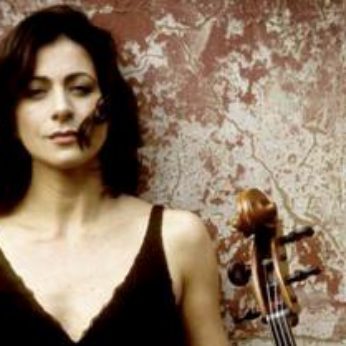Composer: Franz Schubert (b. 1797 - d. 1828)
Performance date: 02/07/2012
Venue: St. Brendan’s Church
Composition Year: 1824
Duration: 00:22:07
Recording Engineer: Anton Timoney, RTÉ lyric fm
Instrumentation: vc, pf
Instrumentation Category:Duo
Artists:
Thomas Larcher -
[piano]
Natalie Clein -
[cello]

The Arpeggione was a strange instrument
invented in 1823 by Johann Georg Stauffer in Vienna. Also known as the Guitarre
d’Amour, it was derived from the Baroque viola da gamba. It was about the size
of a cello with six strings and a fretboard but shaped like a guitar.
Like the viola da gamba, it was held between the knees and played
with a bow. Schubert’s friend the cellist and guitarist Vincent Schuster
mastered this odd creation and it was for him that Schubert wrote this
delightful sonata in 1824. The instrument never caught
on and was soon abandoned, although Schuster wrote a playing method in
1825. The Sonata was published in a cello version in 1871,
which is how it is usually played today, though the instrument went
a fifth higher than the cello. The word Arpeggione is derived from playing the harp.
The piano opens the first movement, followed by the
cello ten bars later; they present a dark, unusually meditative theme for the
first subject of a Sonata. However it does contain the seeds of a second,
highly-cheeky theme which quickly follows. A totally new lyrical melody is now
launched by the piano to a pizzicato accompaniment and is mixed in with the
opening material, particularly the cheeky idea. The
development swings back and forth between these well-contrasted elements
in a most engaging fashion. The movement ends as it began with a calm sequence
and two final chords. This may not be Schubert at his most profound but it is
most entertaining and holds the listener’s attention throughout.
The E major slow movement is the heart of the work and employs a wonderful,
cantabile melody, as fine as any Schubert created for his best songs. It is a
long soulful cantilena and rather than develop it to any degree, Schubert spins
it out with great feeling. It leads straight into the subdued mood which opens the
Rondo finale. The principal rondo theme is another lovely lyrical theme
presented fully before moving to the first contrasting section or episode which
brings back that cheeky idea from the first movement. A gentle dance-like
second episode follows but the cheeky tune pushes its way in again, Schubert
must have had a particular liking for it. The Sonata ends in a gentler mood
bringing back the rondo theme at a leisurely pace, leading to a simple closure.
Copyright © 2025 West Cork Music. All rights reserved.
Designed and developed by Matrix Internet